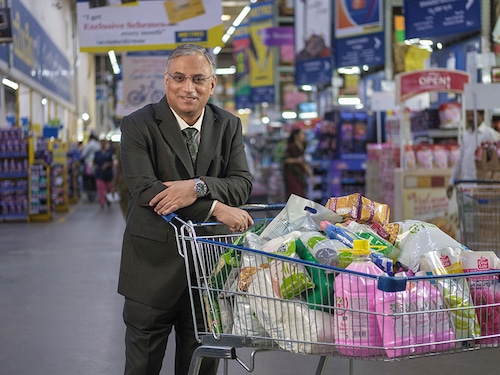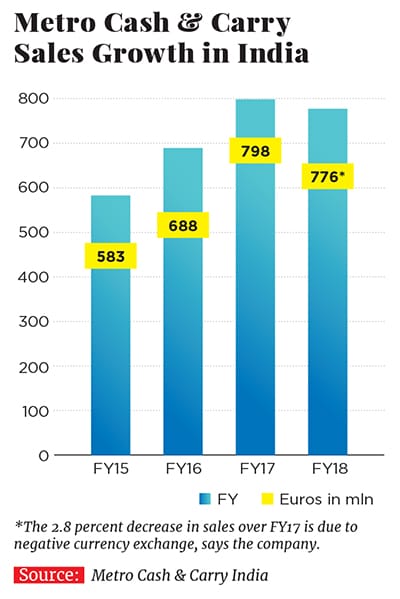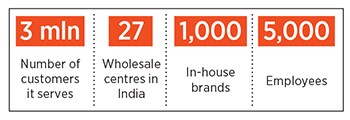How Metro Cash & Carry is helping kirana stores go digital
The company's MD & CEO speaks to Forbes India about its business model, and how the company became profitable 15 years after setting up shop in the country


Arvind Mediratta
Image: Nishant Ratnakar for Forbes India
The India operations of German wholesaler Metro Cash & Carry only turned profitable in September 2018, 15 years after it set up shop in the country. Arvind Mediratta (51), MD and CEO, Metro Cash & Carry India, spoke exclusively to Forbes India on how the company was losing money “hand over fist” and the steps that were taken to plug the financial leakages in the company.
Mediratta, a chemical engineering graduate from IIT-Delhi, took over the reins of Metro Cash & Carry India in 2016, after having setup Walmart’s wholesale operations in the country. With 27 Metro Cash & Carry India centres, Mediratta is now on a mission to save the ubiquitous kirana (neighbourhood retail) stores, a key customer of the wholesaler, accounting for 40 percent of its revenue.
“When our sales force of 800 people spoke to kirana store owners, we realised that they face an existential crisis. Hence, we decided to start sharing the techniques of modern retail with them,” says Mediratta. Edited excerpts from the interview:
Q. Business wise, what position was Metro Cash & Carry India in when you took over?
It was a strong brand, but only in the south. It was a good company, attracting good talent. But was it rated the best? The answer is no. In terms of sales, Metro was [the leading branded wholesaler], but in terms of perceptions, no. When I was running Walmart, it came up quickly and almost caught up with Metro [Metro’s first store opened in 2003, while Walmart opened shop in 2008]. The culture [in Metro Cash & Carry India] needed change—a performance-oriented culture with a strong customer focus. We had to consolidate our leadership position and focus on profitability.  Q. Why did profitability elude the company for 15 years?
Q. Why did profitability elude the company for 15 years?
There was a lot of wastage and many leakages, which have now been plugged. For example, work-related travel: Bookings were done at the last minute…airfares, and even hotel bookings, will cost more, closer to the date of travel. Simple things like that needed to be corrected. There were a lot of examples like that.
The company also needed to improve on its margins and focus on a profitable product mix. Profitability is higher in the sale of non-food items such as apparel and shoes, and there has been a shift in focus to selling more profitable items. We were losing money hand over fist, but now [in the October 2017 to September 2018 fiscal] we have turned profitable. We can’t share exact figures, however.
Q. What are the ‘profitable’ categories that you are focusing on?
Apparel, shoes, household articles such as bedsheets and linen, and home decor. We have also become a destination for fresh chicken and seafood. In commodities like oil, rice and lentils, if you sell olive oil you make more money, as is the case with Basmati rice and organic lentils. So we are shifting the mix. Then, we have our own private labels, which are more profitable for us than other brands. This is across categories from cleaning products to beverages, pulses, rice and spices, and kitchen appliances too. In fact, kiranas make more money from the sale of our private labels.
Besides, the customer gets quality products at a better price. We have more than doubled our own brand portfolio in the past three years.
Q. Do kirana stores stock your private labels?
Yes, they do. Also, as we deal with hotels, restaurants and caterers, our own brands add a lot of value to that customer segment. For example, there is no Hakka noodle brand [in India] but most restaurants require it, whether they are Indian, Chinese or multi-cuisine eateries. So we launched Hakka noodles under our Fine Life brand. About 97 to 98 percent of our brands are manufactured in India by third-party manufacturers. We have about 3 million customers, and most of them are kiranas, hotels and restaurants.
Q. What is your engagement with kirana stores?
The pain points for kiranas [store owners] are that they have to buy commodities from APMC yards and for every FMCG brand, they have to talk to distributors. Besides, they face competition from modern trade and e-commerce companies.
We provide them with everything under one roof—a one-stop shop where they don’t have to deal with multiple suppliers. And in the present GST regime, it’s a much easier way of doing business because it’s easy to get your input tax credit. Besides, our prices are 2 percent lower with other distributors. For example, if an HUL distributor sells an article to a kirana store for Rs 98, and the MRP is Rs 100, we will provide it at Rs 96. This is a question of how we negotiate [with the manufacturer]. Now this 2 percent price benefit that we pass on to the kirana stores results in an additional 25 percent profit for them.
We also allow them credit facility and accept payments through all kind of options. On the demand side we are helping them get more sales from their existing customers by digitising and modernising their stores. Our motto is ‘your success is our business’.
Q. Can you elaborate on that?
About two to three months ago, we launched the concept of ‘Kirana Success Centres’, in line with our motto. We help them convert their stores from a closed format to an open format—from a store where the customer is outside and the shop owner inside, we are saying customers should be able to walk inside, browse, and pick and choose what they want to buy. We have tied up with a company that can do the kirana store makeover in 48 hours. While we did the first few stores for free, we now offer an EMI scheme for this makeover. Secondly, we help in the digitisation of their stores. We provide them with a PoS [point-of-sale] device, which also can be purchased on EMI. With this, they can make utility payments, transfer money, accept digital payments, give money to customers like an ATM machine, and place orders with us. The machine also shares a lot of data on which products sell and which don’t, and who the loyal customers are. So far we have given 100 machines free, and overall, we have digitised 500 kirana stores. We have also created a B2C (business-to-consumer) app for kirana stores, by which consumers can place orders online.
Secondly, we help in the digitisation of their stores. We provide them with a PoS [point-of-sale] device, which also can be purchased on EMI. With this, they can make utility payments, transfer money, accept digital payments, give money to customers like an ATM machine, and place orders with us. The machine also shares a lot of data on which products sell and which don’t, and who the loyal customers are. So far we have given 100 machines free, and overall, we have digitised 500 kirana stores. We have also created a B2C (business-to-consumer) app for kirana stores, by which consumers can place orders online.
One of the digitized kirana stores saw its footfalls jump from 250 to 900, resulting in an over-30-percent jump in sales. If they are successful, they will come back to us. This will also help our own in-house labels. Our intent is to have a higher share of their wallet. We feel that our business model will become outdated if the kiranas are wiped out.
First Published: Feb 26, 2019, 10:37
Subscribe Now